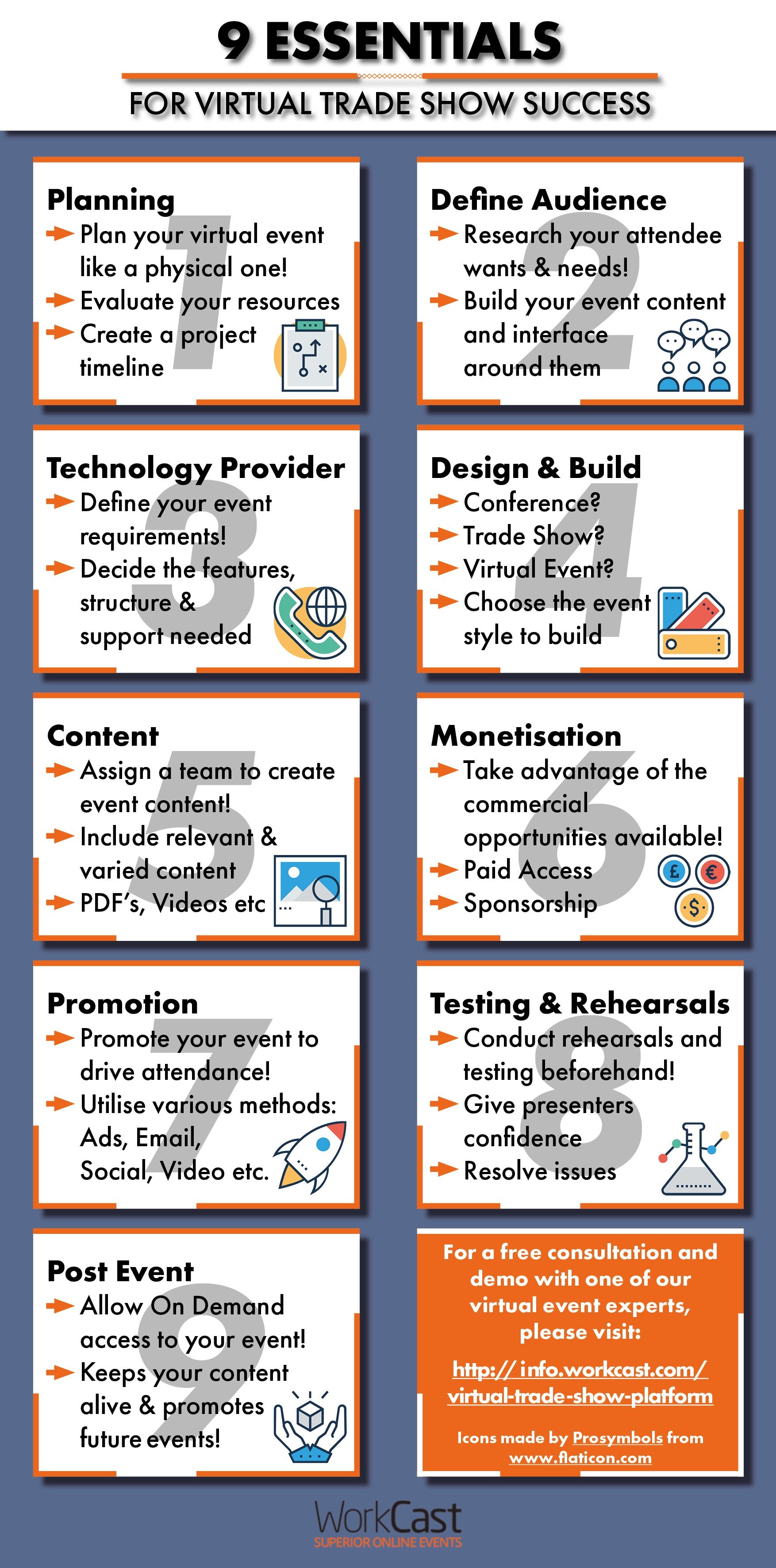With restrictions on how many people can be gathered in the same room and mass event cancellations taking place around the world there has been a huge uptick in demand for virtual trade shows.
But what exactly is a virtual trade show? A virtual trade show is an online trade show environment that allows exhibitors and visitors to connect and interact at virtual trade show booths - basically mini-websites that are build within a larger online event framework. Exhibitors will host a webinar or webcast at their trade show booth to share their regular sales pitch with an online audience that has registered for that event.
Like any event, there can be good virtual trade shows and bad virtual trade shows. Whether yours is successful depends on the planning and strategy behind it.
Here are 10 proven ways you can improve your virtual trade show strategy:
1. Integrate Engagement and Networking Opportunities
One of the biggest differences between an in-person trade show and a virtual trade show is the atmosphere in which your attendees engage with. Typically at trade shows you'll run into old friends, get to strike up conversations with strangers, and there's a certain buzz to the atmosphere (and not just after cocktail hour).
With virtual events, people aren't in the same physical space so we need to build opportunities into the events that allow people to virtually chat, share stories and network. These interactions add significant value to your attendees and can be achieved through:
- Enabling audience chat during events
- Hosting live Q&As where audiences can up-vote questions
- Using a mix of media and transcripts to engage everyone in your audience and make your event more accessible
- Building breakout rooms for your audience
- Including polling questions
2. Include More Enticing CTAs
81% of trade show attendees have buying authority. Don't let that opportunity go to waste. Use your resource section to include next steps people can take to purchase, get a discount, or learn more about the product or service you provide.
You will also want to include both visual and verbal reminders for people to check the resource section and follow your CTAs. The more relevant and enticing you are able to make your CTAs and perks of attending the event, the more likely people are to take that action so get creative and provide incentives.
3. Start Your Event On Time
This might sound obvious, but it needs to be said. Think of how impatient people get when a video doesn't load or people are a few minutes late to a virtual meeting. The same thing happens with your virtual trade show. If you're late to start your events two things are likely to happen.
- People will start to refresh your page thinking there is an error which can cause issues for your online events provider. It adds unexpected strain on their servers which could result in problems.
- People will leave. If you're late to an in-person event, people are usually happy to politely sit there for a while and wait for the speakers. They don't want to be seen by a room full of people as rude or impatient. When your event is virtual, it is much easier to click the X and leave your event.
4. Work On Your Speaker Introductions
Don't just read from somebody's LinkedIn profile, have a chat with them before you script their introduction and make it align with their personality. Let the audience know exactly what's in it for them and why they should sit around to listen to this person. If you can start off on a high note, people will be more open to the rest of your presentation.
Read: The Ultimate Guide to Writing the Perfect Webinar Script
5. Watch Your Rehearsal
The best way to know whether your event will be a success is to watch the rehearsal. Allow yourself to have the full experience as an audience member before asking others to take part in it. If you notice you're getting bored, become disengaged, or confused at any part of the event, look for ways to fix that before you broadcast live.
A few ways to add more excitement to your event could include:
- Adjusting the pacing of your slides so you are clicking through more slides with less information on them. Increasing the movement of slides will help keep peoples' attention and prevent drop off.
- Editing your script or switching speakers more frequently to break up any lengthy monologues that made it into the original draft.
- Mixing your media to include more imagery, GIFs, or videos to help keep your presentation entertaining.
6. Keep Your Event Environment Consistent
If your virtual trade show includes lots of events and breakout sessions, it can be tempting to use different designs, formatting and even templates for different events to keep things interesting. However, making too many changes can negatively impact the user experience so you need to proceed with caution here.
You want attendees to feel comfortable jumping from one event to another, and if they have to look for the 'Ask a Question' button every time because you keep moving it around, they will become frustrated.
If you need to use multiple templates within a single trade show, you can improve the UX by categorizing how you use each template and maintaining that structure. For example, you could have three types of templates within your event that are optimized for their purpose:
- Live and Simulive sessions with a Q&A template
- Breakout round table discussions template
- Private sales meetings room template
Be sure to keep key elements like sign in buttons, audio buttons, and CTA language consistent throughout your entire event regardless of template so it is easier for users to navigate.
7. Manage Your Email Communications Properly
Building email work flows for multi-session events takes time and planning. Scheduling effective communications and reminders for your events will have a huge impact on your registrations and attendance rate.
Optimize your communications for your event structure. If you are running back-to-back events, 1 hour to go and 15 minute email reminders won't be effective because you're emailing people while they're watching another event. Instead you can send people their daily agenda as a calendar invite so they can add the events to the calendar on their phone and get pop-up reminders when the next one is about to start.
8. Design Your Trade Show for Your Demographic
This goes beyond just providing meaningful content and offers that is relevant for your audience. Know and optimize your virtual trade show and booth experience for the devices and browsers they use to attend your event. You can pull all of this information ahead of time based on who you will be targeting for registrations so be sure to take the extra step and optimize your experience for their technology.
If you can provide an excellent online experience for your trade show attendees, they are more likely to trust what you have to say and will be easier for you to convert into SQLs or customers.
Discover 7 Tips For Designing A Virtual Trade Show Booth
9. Ask for Feedback
Just like at in-person events, you will want to ask for attendee feedback at every stage of your virtual trade show so you can make incremental improvements to your upcoming sessions. You can do this using polling questions or by asking and incentivizing people to complete sessions at the end of each event.
One of the biggest advantages of a virtual trade show is the data and analytics provided on both an event and attendee level. Your reporting dashboard will show you the number of questions asked, how long people watched a session for, attendee engagement scores, and more. Layering on qualitative data to your event reporting will help you make significant improvements to your next virtual trade show, but you have to put in the effort to collect that feedback.
10. Automate Your Follow-up
Automating your virtual trade show follow-up is easy and will help you convert more leads. The data in your reporting dashboard will help you accurately score leads and event attendees more accurately to triage and group your leads based on intent. This data can even be integrated with your CRMs or marketing automation tools like HubSpot. All you need to do is have your email lists and workflow communications ready to help nurture these leads into customers.
Designing a virtual trade show that will wow your audience takes a lot of time and planning compared to in-person events. You need to consider the entire customer journey to your virtual event, rather than just focusing on having a good chat when somebody arrives at an in-person trade show booth at a venue that is already set up. Incorporating these ten tips into your planning and execution strategy will help ensure your next virtual trade show is a success.
Learn How To Create A Virtual Event On A Budget in our free webinar.
Share this
You May Also Like
These Related Stories

9 Essentials For Virtual Trade Show Success (Infographic)

7 Tips For Designing An Online Trade Show Booth



